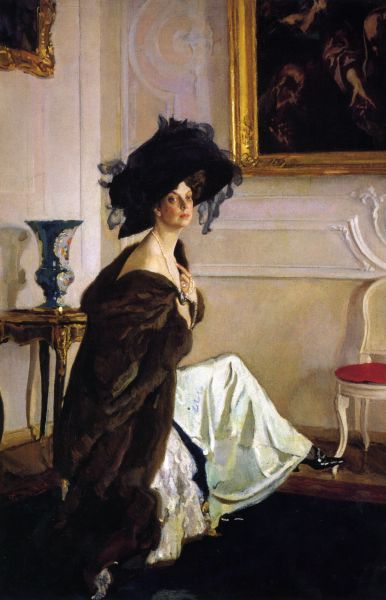|
|
Portrait of Princess Olga Orlova. 1911

Serov Valentin,
Oil on canvas
237,5 x 160
State Russian Museum
Annotation
Valentin Serov followed the traditions of Russian official portraiture, as exemplified by Dmitry Levitsky and Karl Brullov in the eighteenth and nineteenth centuries.
This representative canvas contains many features of a high style. Proud and narrow-minded, Princess Olga Orlova may not have been beautiful, but she had that special pedigree that comes with breeding. Olga was considered the most elegant woman in the Russian capital; it was said that no one in St Petersburg wore a hat better that she. The skilful and dynamic composition, the restrained and noble tones, the sharp silhouette, the gesture of the well-groomed hand and the “enamel” painting are all intended to paint a psychological picture of this lioness of Russian and European society. The expression in the sitter’s eyes is both haughty and dreamy. Serov showed the portrait to great acclaim at the Esposizione Internazionale di Roma in 1911.
Princess Olga Konstantinovna Orlova (née Princess Beloselskaya- Belozerskaya) (1872–1923): Wife of Major-General Prince V. N. Orlov.
Author's Biography
Serov Valentin
Serov, Valentin Alexandrovich
1865, St Petersburg - 1911, Moscow
Painter, graphic artist, teacher, portraitist, landscapist, history painter. Son of the composer Alexander Serov. Studied under Ilya Repin in Paris and Moscow (1874-75, 1878-80) and under Pavel Chistyakov at the Imperial Academy of Arts (1880-85). Academician of painting (1898), full member of the Imperial Academy of Arts (1903-05). Member of the Abramtsevo circle (from the 18705). Contributed to exhibitions (from 1889). Contributed to the exhibitions of the Society of Travelling Art Exhibitions (1890-99; member from 1894), Munich Sezession (1896, 1898,1899; member from 1899), Exhibition of Russian and Finnish Artists (1898), World of Art (1896-1906, member from 1900; 1911-12, founding member), Berlin Sezession (1903), Exhibition of Historical Russian Portraits at the Tauride Palace in St Petersburg (1905), Union of Russian Artists (1905-10; member from 1903), Sergei Makovsky Salon (1909), Exposition Universelle in Paris (1900, grand prix), International Exhibitions in Munich (1909), Vienna (1902), Venice (1907), Brussels (1910) and Rome (1911) and the Exhibitions of Russian Art in Paris (1906, 1910), Berlin (1906) and Vienna (1908). Member of the board of the Tretyakov Gallery. Taught at the Moscow School of Painting, Sculpture and Architecture (1897-1909). Designed for theatres in Moscow and St Petersburg and Sergei Diaghilev''s Saisons Russes (from 1886).

